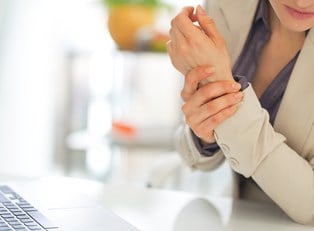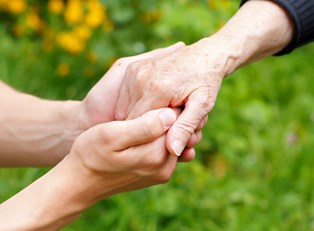Osteoarthritis (degenerative joint disease; osteoarthrosis) is the most common form of arthritis, affecting nearly 21 million Americans. It occurs when cartilage in one's joints degrade over time, usually in the hands, wrists, hips, knees, neck and lower back. Cartilage is a firm, but elastic, material that reduces friction in the joints to serve as a natural shock absorber.
Osteoarthritis causes the cartilage to stiffen, making it susceptible to damage and deterioration over time. The nearby tendons and ligaments stretch in reaction to this, which causes the pain, swelling, and stiffness. Mechanical stress may underlie all osteoarthritis, so it's important to look at what causes mechanical stress. Researchers suspect it is a combination of factors including the natural aging process, joint injury or stress, heredity, muscle weakness, and obesity. One should consult a physician if he or she is experiencing swelling and/or stiffness in the joints for more than two weeks. Osteoarthritis diagnosis is based on medical history and clinical examination, usually including x-rays. There is no known cure; however, osteoarthritis treatment can generally be categorized into three main areas: Physical Therapy, Lifestyle Modification, and Medication. Adherence to a strict treatment plan is crucial to continued quality of life.
Osteoarthritis Symptoms
Though they can pinpoint some osteoarthritis risk factors, experts don't know exactly why the cartilage in joints break down. But this breakdown is what causes the telltale symptoms. The number one osteoarthritis symptom is joint pain. The joints may ache, feel like they're burning or produce a sharp, knifing sensation. Morning stiffness is another common symptom. Getting up in the morning can be a difficult, painful process as one tries to use stiff and locked joints. Stiffness may also occur from shorter periods of inactivity such as watching television. When activity decreases, due to joint pain and stiffness, the surrounding muscles begin to atrophy and weaken. This is most common with arthritis in the knee. Another prevalent osteoarthritis symptom is swelling. As damaged membranes in the joints allow more fluid to enter the joint cavities, they begin to swell and grow more tender and sore. Joints can also become deformed due to stretched ligaments and damaged bones. As the condition progresses, range of motion will decrease. One may not be able to fully bend, flex, or extend the joints, and in more severe cases complete immobility is possible. An audible cracking, crunching, or creaking sound when bending or extending the joint is another sign and symptom of osteoarthritis.
Long-Term Osteoarthritis Symptoms
Osteoarthritis is a chronic (long-term) disease that has no cure, but in most cases, the symptoms and progression can be relieved and slowed. Periodically osteoarthritis symptoms may fade or disappear completely. This is called a remission. Similarly, the pain, swelling and other symptoms may return or intensify. This is called a flare-up. It is recommended that any exercises or physical therapy regimen be reduced during a flare-up and resumed during remission. A doctor's appointment should be made if one has swelling or stiffness in his or her joints for more than two weeks. If already on medication for osteoarthritis, one should contact a doctor if side effects such as nausea, abdominal discomfort, black or tarry stools, constipation or drowsiness persist. These may be the result of osteoarthritis treatment. Another long-term symptom is the occurrence of hard, bony enlargements, called nodes which may form in smaller joints. Osteoarthritis may also lead to bunions on the toes. This degenerative disease worsens over time. Joint pain and stiffness may reach a level of severity that makes getting through a normal day's routine nearly impossible. If this occurs, doctors may recommend joint replacement surgery. Knee surgery for Osteoarthritis however has been found to have no better effect than placebo at relieving symptoms.



